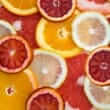Background
- Hesperidin is a flavonoid found in citrus fruits such as lemons, oranges, and grapefruits before they ripen. Hesperidin is available as a supplement, both alone and in combination products with other ingredients. Scientific studies of the effects of hesperidin have used these combination products. As a result, conclusions about the effects of hesperidin alone cannot be made based on the available studies.
- Hesperidin may have antioxidant and antimicrobial properties. It may have effects on the immune system and help prevent disease. The combination products that contain hesperidin and other ingredients may have beneficial effects on blood vessels.
References
- Aguilar Peralta GR, Arévalo Gardoqui J, Llamas MacÃas FJ, et al. Clinical and capillaroscopic evaluation in the treatment of chronic venous insufficiency with Ruscus aculeatus, hesperidin methylchalcone and ascorbic acid in venous insufficiency treatment of ambulatory patients. Int Angiol 2007;26(4):378-84.
View Abstract - Chiou CS, Lin JW, Kao PF, et al. Effects of hesperidin on cyclic strain-induced endothelin-1 release in human umbilical vein endothelial cells. Clin Exp Pharmacol Physiol 2008;35(8):938-43.
View Abstract - Demonty I, Lin Y, Zebregs YE, et al. The citrus flavonoids hesperidin and naringin do not affect serum cholesterol in moderately hypercholesterolemic men and women. J Nutr 2010;140(9):1615-20.
View Abstract - Etcheverry SB, Ferrer EG, Naso L, et al. Antioxidant effects of the VO(IV) hesperidin complex and its role in cancer chemoprevention. J Biol Inorg Chem 2008;13(3):435-47.
View Abstract - Garg A, Garg S, Zaneveld LJ, et al. Chemistry and pharmacology of the Citrus bioflavonoid hesperidin. Phytother Res 2001;15(8):655-69.
View Abstract - Guex JJ, Enriquez Vega DM, Avril L, et al. Assessment of quality of life in Mexican patients suffering from chronic venous disorder - impact of oral Ruscus aculeatus-hesperidin-methyl-chalcone-ascorbic acid treatment - 'QUALITY Study'. Phlebology 2009;24(4):157-65.
View Abstract - Hosseinimehr SJ, Mahmoudzadeh A, Ahmadi A, et al. Radioprotective effects of hesperidin against genotoxicity induced by gamma-irradiation in human lymphocytes. Mutagenesis 2009;24(3):233-5.
View Abstract - Iriz E, Vural C, Ereren E, et al. Effects of calcium dobesilate and diosmin-hesperidin on apoptosis of venous wall in primary varicose veins. Vasa 2008;37(3):233-40.
View Abstract - Kalpana KB, Srinivasan M, Menon VP. Evaluation of antioxidant activity of hesperidin and its protective effect on H2O2 induced oxidative damage on pBR322 DNA and RBC cellular membrane. Mol Cell Biochem 2009;323(1-2):21-9.
View Abstract - Kim YS, Kim JJ, Cho KH, et al. Biotransformation of ginsenoside Rb1, crocin, amygdalin, geniposide, puerarin, ginsenoside Re, hesperidin, poncirin, glycyrrhizin, and baicalin by human fecal microflora and its relation to cytotoxicity against tumor cells. J Microbiol Biotechnol 2008;18(6):1109-14.
View Abstract - Lee CJ, Wilson L, Jordan MA, et al. Hesperidin suppressed proliferations of both human breast cancer and androgen-dependent prostate cancer cells. Phytother Res 2010;24 Suppl 1:S15-9.
View Abstract - Lee KH, Yeh MH, Kao ST, et al. The inhibitory effect of hesperidin on tumor cell invasiveness occurs via suppression of activator protein 1 and nuclear factor-kappaB in human hepatocellular carcinoma cells. Toxicol Lett 2010;194(1-2):42-9.
View Abstract - Nizamutdinova IT, Jeong JJ, Xu GH, et al. Hesperidin, hesperidin methyl chalone and phellopterin from Poncirus trifoliata (Rutaceae) differentially regulate the expression of adhesion molecules in tumor necrosis factor-alpha-stimulated human umbilical vein endothelial cells. Int Immunopharmacol 2008;8(5):670-8.
View Abstract - Saha RK, Takahashi T, Suzuki T. Glucosyl hesperidin prevents influenza a virus replication in vitro by inhibition of viral sialidase. Biol Pharm Bull 2009;32(7):1188-92.
View Abstract - Yeh MH, Kao ST, Hung CM, et al. Hesperidin inhibited acetaldehyde-induced matrix metalloproteinase-9 gene expression in human hepatocellular carcinoma cells. Toxicol Lett 2009;184(3):204-10.
View Abstract







